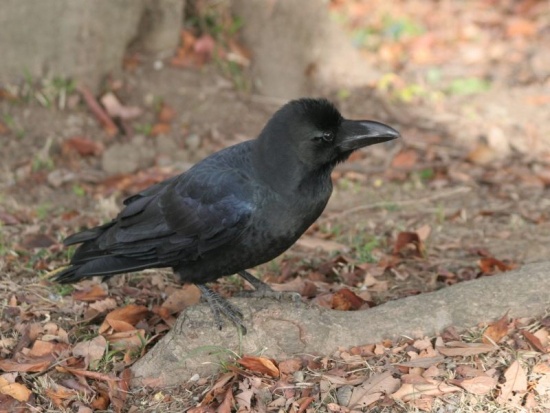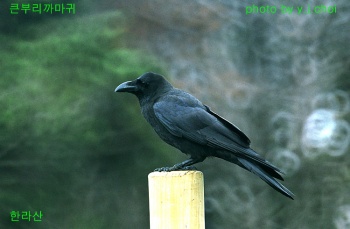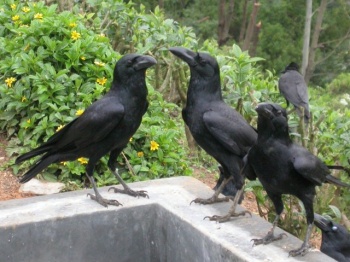Alternative names: Jungle Crow; Thick-billed Crow; Black Crow; Japanese Crow (japonensis, connectens, osai), Eastern Jungle Crow (levaillantii); Indian Jungle Crow (culminatus)
- Corvus macrorhynchos
Identification
46-59 cm (18-23¼ in). The different subspecies differ greatly in size.
- Long bill with the upper mandible quite thick and arched, making it look heavy. The bill size differs greatly with the subspecies.
- Macrorhynchus with a distinctively peaked forehead, other subspecies to a lesser extent
- Dark greyish plumage from the back of the head, neck, shoulders and lower body. Almost black in Indian forms.
- Wings, tail, face and throat are glossy black
- Dark brown iris
- Black legs and bill
Sexes similar. Juveniles with less glossy plumage and a smoky blue iris.
Similar species
Very similar to Slender-billed Crow. Note the concealed culmen base in Large-billed Crow, the longer tail in flight and the more obviously fingered primaries. May also be confused with Carrion Crow and Common Raven in parts of its range.
Distribution
Found in south and east Asia.
From Afghanistan over the Indian Subcontinent, the Himalayas and central, south and east China to Korea, the far east of Russia to Japan. Also to Burma, Thailand, Indochina, peninsular Malaysia to Sumatra, Java, Borneo and the Sundas to Timor and Wetar. A regional form occurs on the Philippines.
Common and widespread in most of its range. Rather rare in Borneo. Records from Iran, north Afghanistan, Turkmenistan and Tajikistan are probably erroneous.
Taxonomy
Unresolved. Varies by authority. Pending further research, may be split into as many as four different species.
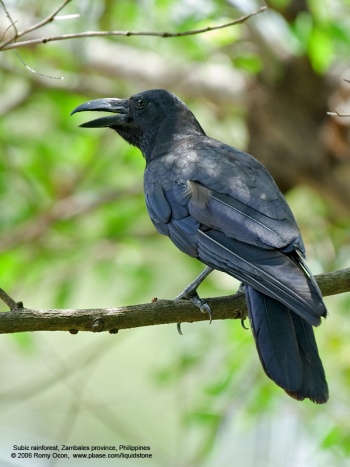
Photo © by Romy Ocon
Subic rainforest, Zambales province, Philippines, 22 June 2006
Subspecies
This is a polytypic species with 13 subspecies currently recognized[1].
- Large-billed group
- C. m. japonensis in Sakhalin, Kuril Islands and northern Japanese Archipelago
- C. m. connectens on southern Ryukyu Islands (Amami-O-Shima, Okinawa and Miyako-Jima)
- C. m. osai on southern Ryukyu Islands (Ishigaki, Iriomote, Kohama, Kuru and Aragusuku)
- C. m. mandshuricus in northeast Asia
- C. m. colonorum in northern China to northern Indochina and Taiwan
- C. m. hainanus in Hainan (southern China)
- C. m. mengtszensis in southwest China (southern Yunnan)
- C. m. tibetosinensis in eastern Himalayas to southeast Tibet, northern Myanmar and western China
- C. m. intermedius in extreme eastern Iran to northwest India and western Himalayas
- C. m. macrorhynchos in southern Indochina, the Thai-Malay Peninsula, Sumatra, Java, and the Lesser Sundas
- C. m. philippinus in Philippine Islands
- Indian Jumgle group
- Eastern group
Habitat
Woodland, parks and gardens. In north of range often near rivers and settlements near rivers.
Up to 2000 m in Sri Lanka, 4500m in Sikkim and 5000m in Tibet. Known to follow mountaineers as high as 6400m.
Behaviour
Usually seen in pairs or family parties, often associating with other birds like House Crow
Breeding
The nest is a platform of twigs, usually high up on a tree with a preference for tall conifers like Fir or Pine. There are normally 3-5 eggs laid and they are incubated for 17-19 days. The young are fledged usually by about the 35th day.
Diet
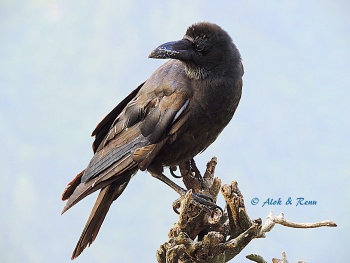
Photo © by Alok Tewari
Bairagarh, Dist. Chamba, Alt. 7900 ft, India, 18 June 2014
Feeds on carrion of all kinds. Forages along shorelines and roadsides, robs bird nests, steals food from vulture nests, kills palm-squirrels and rodents, frogs, lizards, crabs and insects. Takes also fruit, nectar and petals.
Movements
A resident species. Birds of northern populations move to the coast (ice-free river-mouths) in winter.
Vocalisation
Complex, with variations within the vocabulary of each subspecies. Japanese birds give a variety of laughing and harsh, clear calls, hoarser than [Carrion Crow].
References
- Clements, J. F., T. S. Schulenberg, M. J. Iliff, D. Roberson, T. A. Fredericks, B. L. Sullivan, and C. L. Wood. 2018. The eBird/Clements checklist of birds of the world: v2018. Downloaded from http://www.birds.cornell.edu/clementschecklist/download/
- Del Hoyo, J, A Elliott, and D Christie, eds. 2009. Handbook of the Birds of the World. Volume 14: Bush-shrikes to Old World Sparrows. Barcelona: Lynx Edicions. ISBN 978-8496553507
- Rasmussen, PC and JC Anderton. 2005. Birds of South Asia: The Ripley Guide. Barcelona: Lynx Edicions. ISBN 978-8487334672
- Birdforum thread discussing the large number of potential future splits of this species
- Madge, S. (2019). Large-billed Crow (Corvus macrorhynchos). In: del Hoyo, J., Elliott, A., Sargatal, J., Christie, D.A. & de Juana, E. (eds.). Handbook of the Birds of the World Alive. Lynx Edicions, Barcelona. (retrieved from https://www.hbw.com/node/60796 on 2 April 2019).
- Nelson, Mike (May 17, 2013). "Vocal variation and future splits of the Large-billed Crow complex". Xeno-Canto. Retrieved 3 June 2017
Recommended Citation
- BirdForum Opus contributors. (2024) Large-billed Crow. In: BirdForum, the forum for wild birds and birding. Retrieved 24 April 2024 from https://www.birdforum.net/opus/Large-billed_Crow
External Links
GSearch checked for 2020 platform.1




